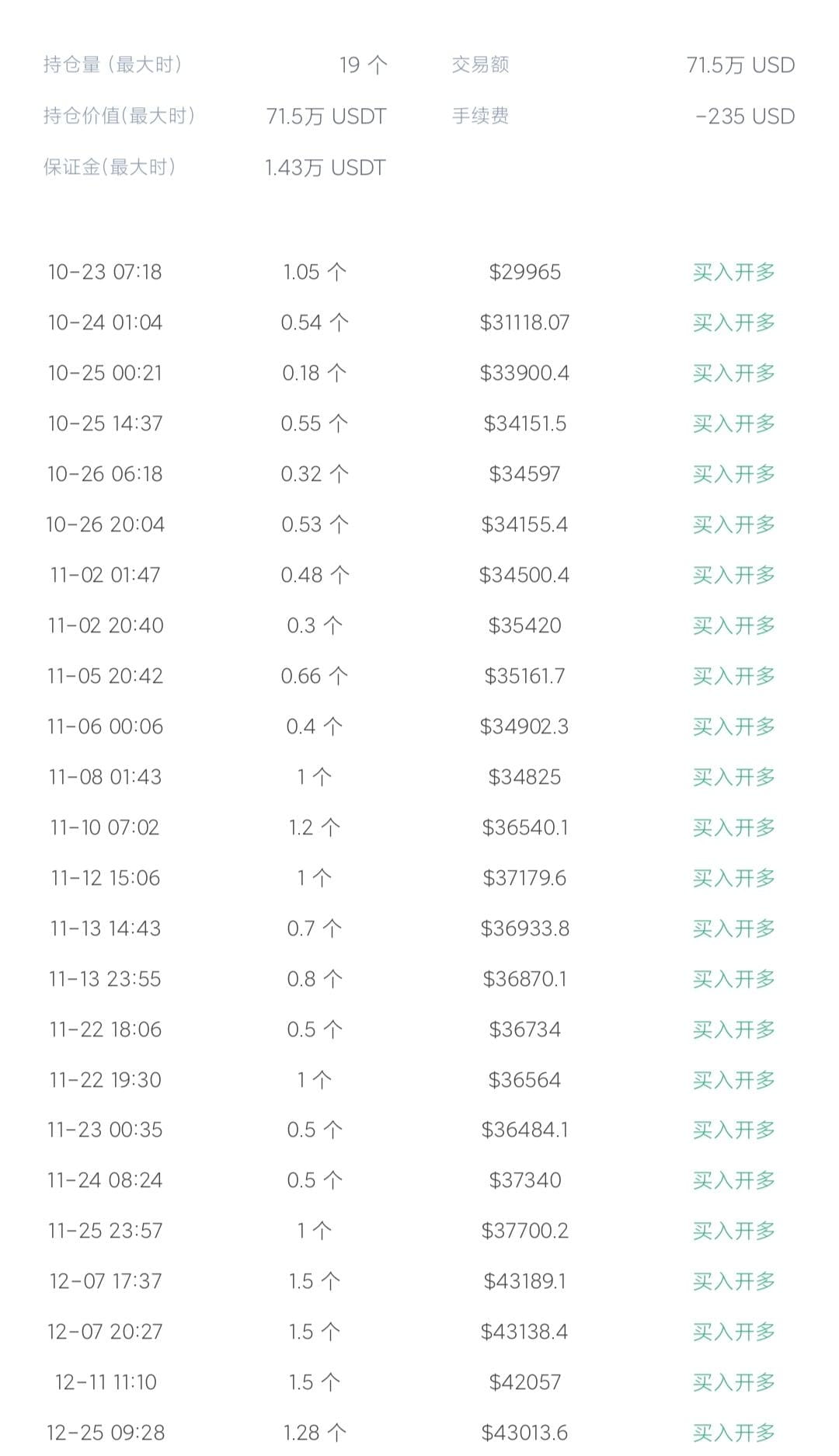If you want to change your fate in the traditional speculative market, it comes down to: buy early, buy low, buy more. In the cryptocurrency market, rolling positions are almost the only way to quickly turn the tables.
Volatility breakout strategy.
It is a quantitative trading method that captures trends by capturing abnormal expansions in market volatility, summarized into the following five core dimensions:
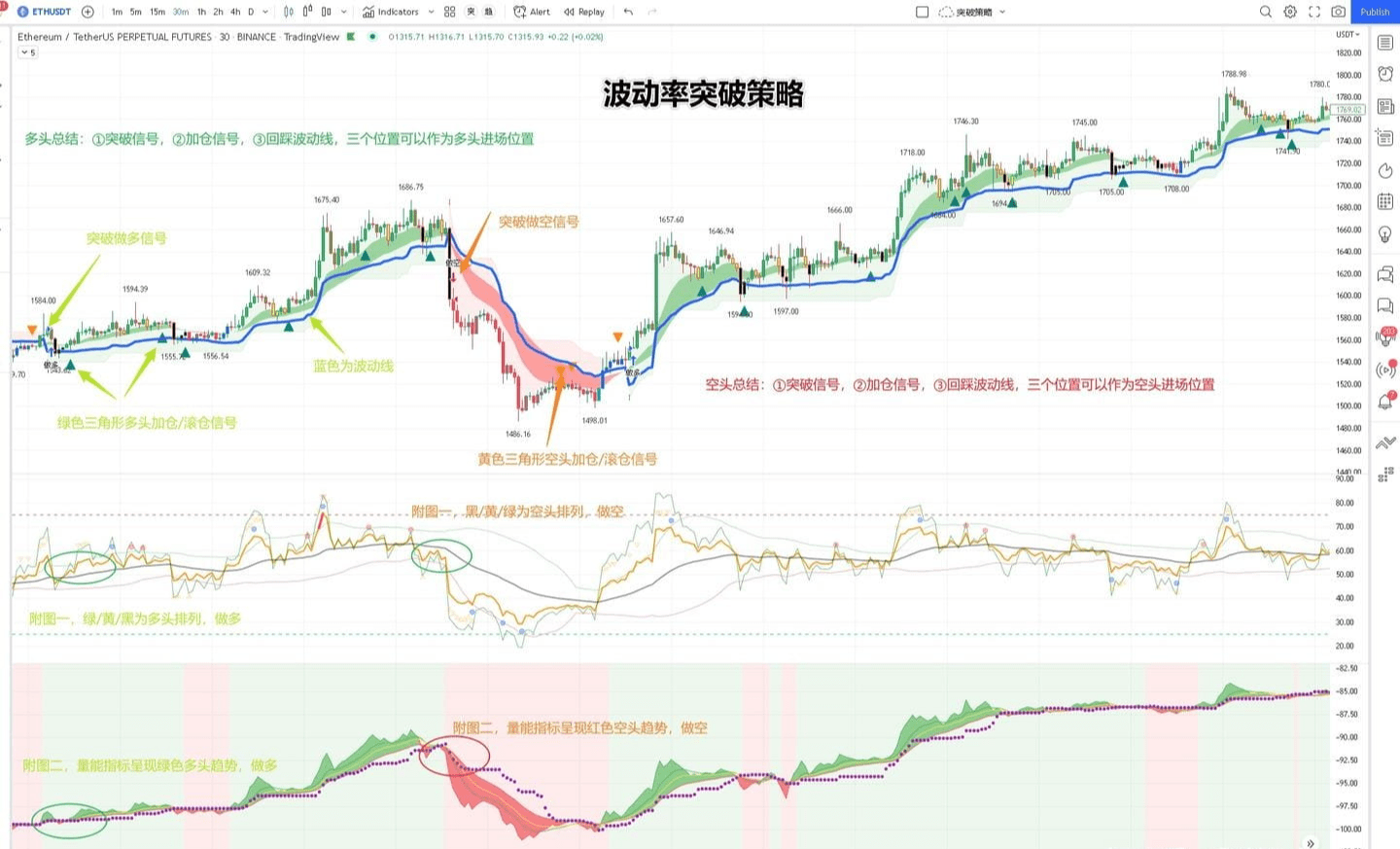
Volatility breakout strategy.
As shown in the figure above, the main chart is the breakout strategy and the addition signal, serving as the entry signal. The auxiliary chart one is the long-short dynamic index, used to judge locked profits. The auxiliary chart two is the volume indicator, which assists in trend judgment.
1. Core operating mechanism.
Volatility quantification and dynamic threshold setting: The strategy is based on historical volatility (such as 20-day standard deviation) to calculate the normal volatility range of the market, identifying abnormal volatility through dynamic threshold settings (such as 1.5 times historical average volatility). When real-time volatility breaks through the threshold, it triggers trading signals. For example, combine ATR verification of breakout amplitude ≥ 1.2 times ATR in Bollinger Band breakouts, significantly improving signal effectiveness.
Multi-level signal verification system: Advanced strategies often integrate multi-dimensional verification.
Trend filtering: Use EMA dual moving averages (e.g., 50/200 periods) to confirm the main trend direction.
Momentum verification: Combine RSI overbought and oversold regions (RSI < 30 or >70) to judge reversal potential.
Pattern confirmation: Must match hammer lines, morning star, and other candlestick reversal patterns.
Volume support: The trading volume during the breakout must increase to 1.5 times the 20-day average volume.
2. Strategy advantages.
High profit-loss ratio and event-driven adaptability stand out in sudden events (such as central bank decisions, geopolitical conflicts). In the crude oil futures case, capturing a $9 swing profit increased threefold compared to traditional strategies. The profit-loss ratio often reaches 3:1 since stop-losses are dynamically set based on ATR (e.g., 1.5 times ATR), while profit-taking is anchored to volatility expansion.
Adaptive market environment: Adjust parameters dynamically to respond to different volatility states.
During high volatility periods, shorten the EMA period to 12 days and tighten the standard deviation multiple of the Bollinger Bands to 1.5.
During low volatility periods, use 'volatility anchoring', where position size is inversely linked to ATR (if volatility rises by 10%, position decreases by 15%).
Set parameters by scenario, for example, use ATR(14)+k=2.0 for intraday trading, and ATR(28)+k=3.0 for long-term holding.
Multi-market universality has been validated for:
High volatility varieties: Bitcoin, crude oil (annualized volatility > 40%).
Stock index futures: S&P 500 strategy win rate 68%, Sharpe ratio 2.3.
Foreign exchange market: Euro/USD breakout verification system eliminates 82% of false signals.
Three, key optimization directions.
1. Volatility state identification system.
Compression period warning: Start breakthrough preparation when the Bollinger Band width / ATR<0.6.
Wave cycle capturing: Combine the VIX index and implied volatility percentiles (build positions at the 30% percentile).
Dual mode switching: Normal mode increases TD series filtering, event mode uses news API triggers.
2. Non-linear stop-loss mechanism.
Initial stop loss at 1.5 times ATR, tighten to 0.8 times after profits exceed 2 times ATR.
For S&P 500, use volatility cone analysis to set different stop losses at varying percentile ranges.
In the options double buy strategy, use vega value to monitor volatility premiums; if the premium loss exceeds 30%, force exit.

How to use the volatility breakout strategy for effective trading?
1. Use the volatility breakout strategy for intraday contracts. The benefit is being able to buy in time when the stock price breaks upwards, confirming that your trading direction is correct, and simplifying the complexity of trading decisions. However, this strategy also has some drawbacks, such as easily buying at the peak and identifying and responding to false breakouts; therefore, traders need to possess good trading skills and risk control abilities.
The volatility breakout strategy has a win rate of around 70%, with a profit-loss ratio of 2.37. If the execution aligns with the strategy signals, the returns are quite good.
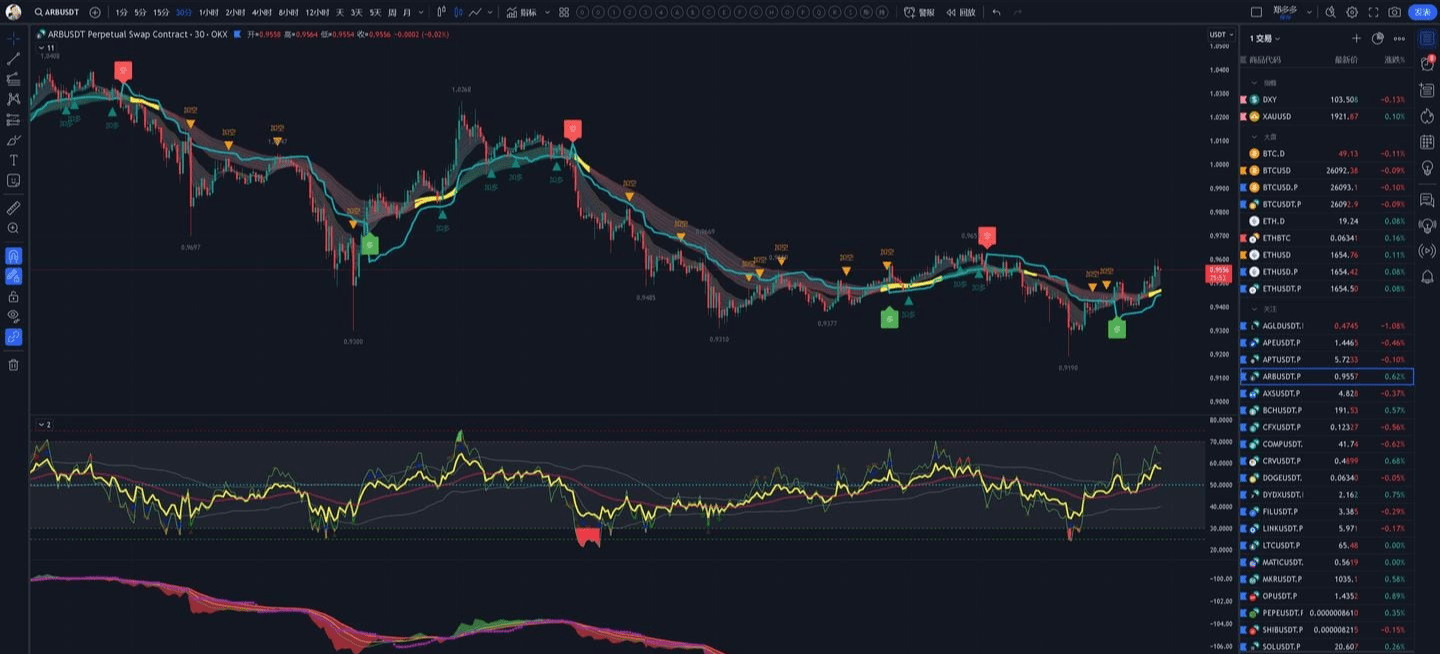
ARB gold standard 30-minute cycle perpetual contract.
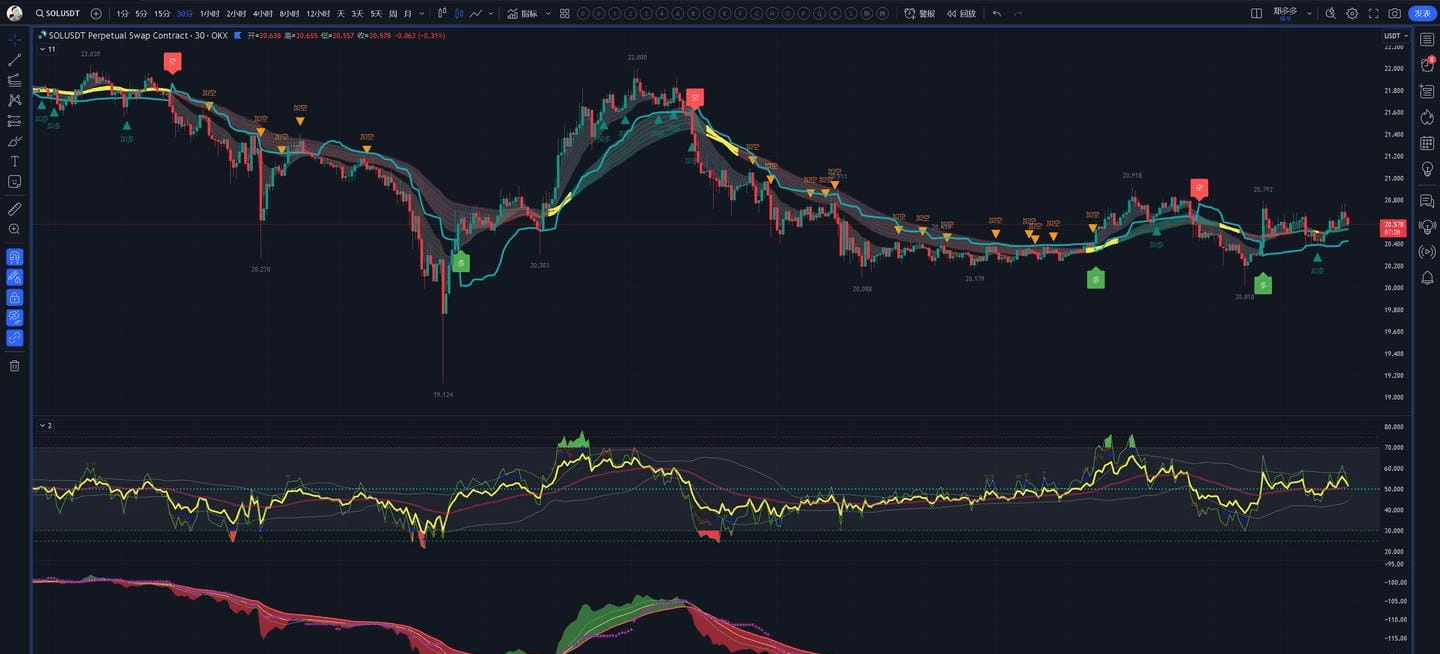
SOL gold standard 30-minute cycle perpetual contract.
2. Use the volatility breakout strategy for large cycle trend rolling position trading. As shown in the figure below, the addition signals under the large cycle provide good rolling entry positions.
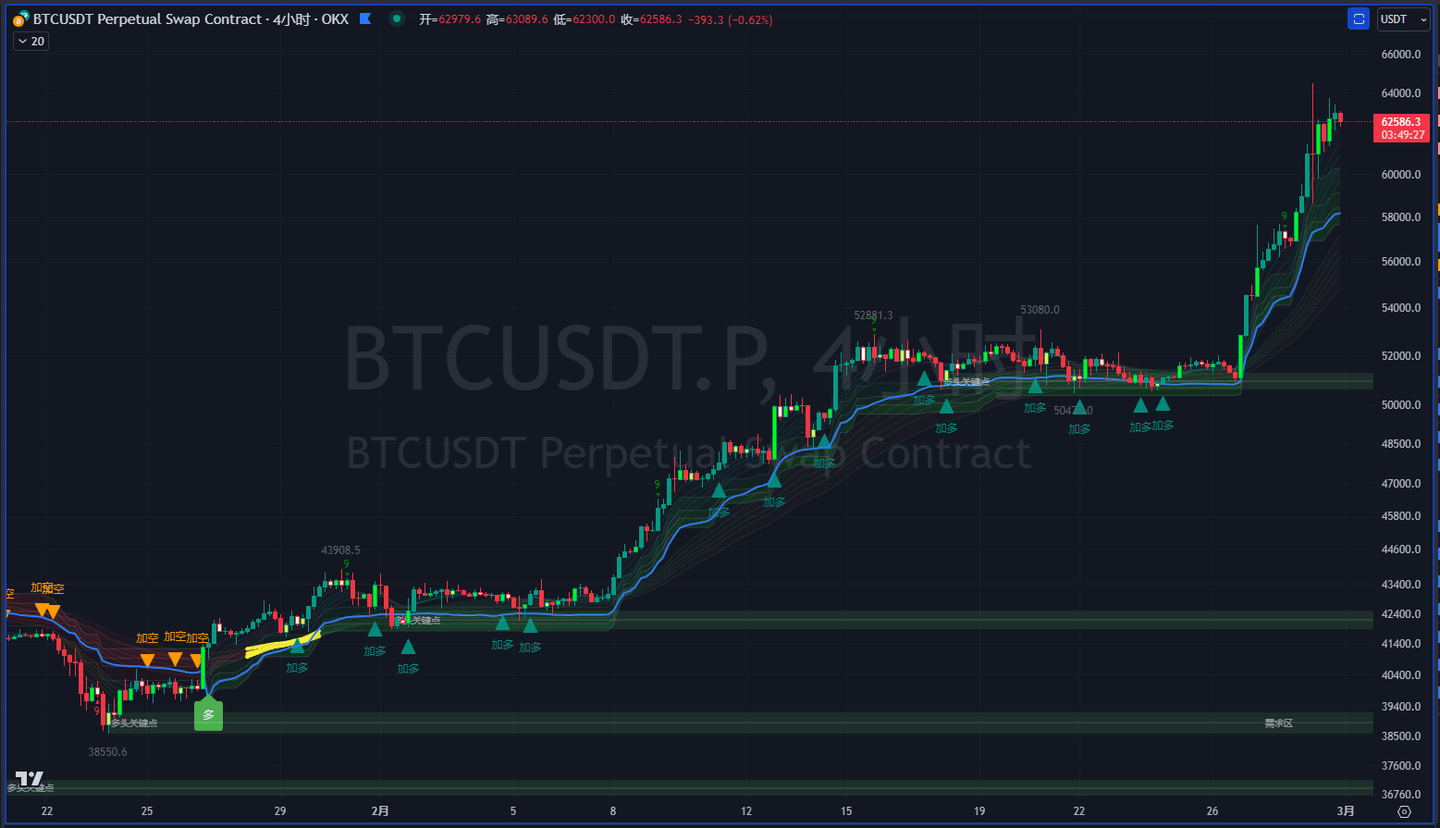
From January 22 to February 29, Bitcoin 4-hour breakout strategy addition signals, rolling position.
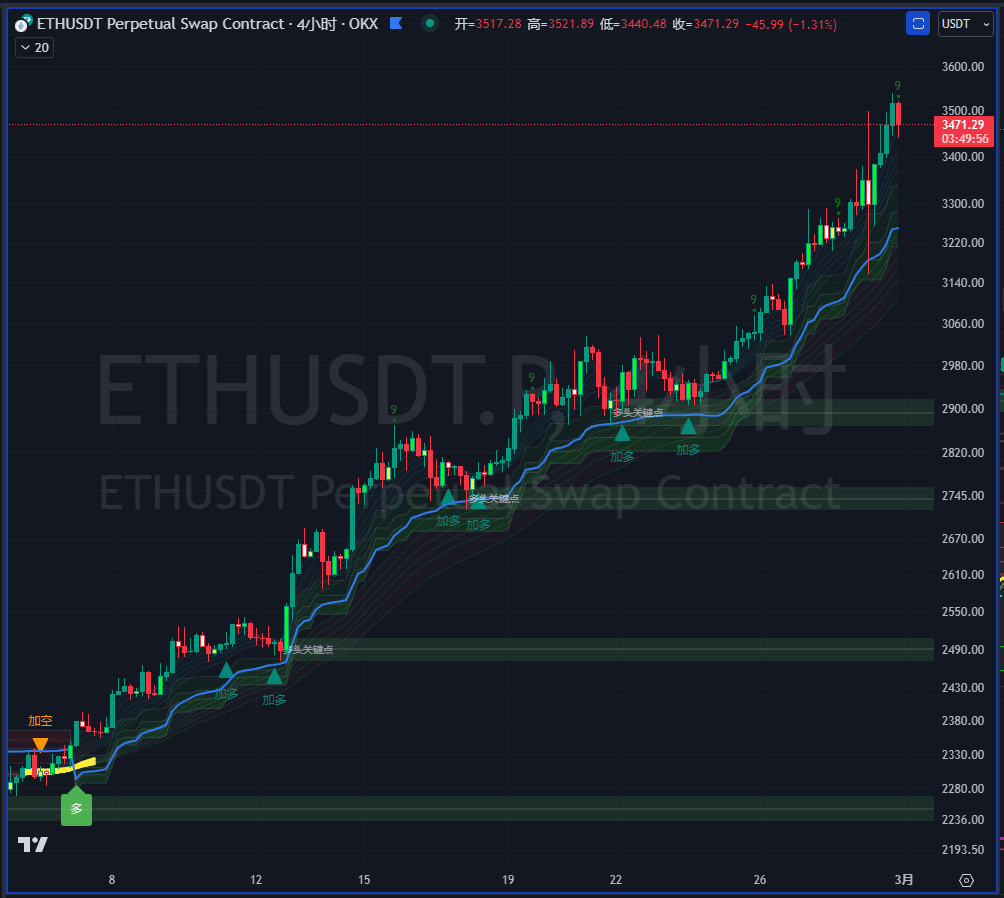
February 7 to February 29, Ethereum 4-hour breakout strategy addition signal, rolling position.
Defying fate—using volatility breakout strategies for rolling position trading's theoretical foundation.
1. Three applicable situations for rolling positions.
Rolling positions sound scary, but in another way, it’s floating profit addition. Saying floating profit addition makes it sound much better. Floating profit addition is just an ordinary technique in futures trading.
You don’t have to maintain a 5-10 times leverage; you only need two to three times. The goal is to maintain a total position of two to three times with floating profits. Trading Bitcoin is relatively safe, and rolling positions are only suitable in three situations:
Choosing direction after long-term sideways volatility reaches new lows.
Buying the dip after a significant decline following a substantial bull market rally.
Breaking through significant resistance/support levels on a weekly chart.
Only in these three situations does the chance of success become relatively large; all other opportunities should be given up.
(Tip: Only use money that you don’t mind losing to trade futures.)
Viewpoint:
Define rolling positions: In trending markets, utilize leverage to achieve significant profits, and because overall leverage passively decreases, increase trend positions at the right time to achieve compound profit effects.
The process of increasing positions is called rolling positions.
The defined 'appropriate time' refers to two main types:
1. Add positions in converging breakout trends; after the breakout, quickly reduce the added position.
2. In the trend's pullback, increase trend positions, such as buying in batches at moving average pullbacks.
2. Capital management.
Trading is not full of risks; risks can be mitigated through capital management. For example, I have a futures account of 200,000 and a spot account ranging from 300,000 to over 1 million randomly. When opportunities are high, I invest more; when there are no opportunities, I invest less.
If luck is on your side, you could earn over 10 million RMB in a year, which is quite enough. If luck is not on your side, in the worst-case scenario, your futures account gets liquidated. No worries, the profits from spot trading can cover the losses from futures liquidation. After compensating, you can reinvest; isn't it impossible to earn nothing in spot trading for a year? I'm not that inexperienced.
You can lose money but cannot afford to lose, so I've long ago been liquidated. In futures, I often take out a quarter or one-fifth of the profit separately. Even when I realize profits, I will retain some.
As an ordinary person, my personal advice is to use one-tenth of your spot position to trade futures. For example, if you have 300,000, use 30,000 to trade. If you get liquidated, invest profits from spot trading back in. After you’ve been liquidated ten or eight times, you’ll surely pick up some tricks; if you haven’t, then don’t play; it’s not suitable for you.
3. The risks of rolling positions.
Let's talk about rolling positions. Many people think this is risky; I can tell you the risk is very low, much lower than the logic of trading futures.
If you only have 50,000, how to start with 50,000? First, this 50,000 should be your profit. If you are still at a loss, then don’t look at it.
If you open a position when Bitcoin is at 10,000, set leverage to 10x, using isolated margin, only opening 10% of the position, which means only opening 5,000 as margin. This is essentially 1x leverage, with a 2% stop loss. If you hit the stop loss, you only lose 2%, just 2%? 1,000. How do people get liquidated? Even if you get liquidated, isn't it just a 5,000 loss? How could you lose it all?
If you're right and Bitcoin rises to 11,000, you continue to open 10% of total funds, similarly setting a 2% stop loss. If you hit the stop loss, you still earn 8%. What about the risk? Isn't the risk very high?
And so on...
If Bitcoin rises to 15,000, you should be able to add positions smoothly during this 50% market move, potentially earning around 200,000. Catching two such market movements would mean around 1 million.
There is fundamentally no such thing as compounding; 100 times is made through two 10 times, three 5 times, or four 3 times returns, not through 10% or 20% compounding every day or month; that’s nonsense.
This content not only contains operational logic but also encompasses the core internal skills of trading, position management. As long as you understand position management, you won't lose everything.
This is just an example; the general idea is like this, but the specific details need to be pondered more by oneself.
The concept of rolling positions itself does not have risk; not only is it risk-free, but it is also one of the most correct ideas in futures trading. The risk lies in leverage. 10x leverage can roll, and 1x can do the same. I generally use two to three times leverage; catching two moves can yield dozens of times returns. If all else fails, you can use a fraction of a leverage. How does this relate to rolling positions? This is clearly your own choice of leverage; I have never said to operate with high leverage.
Moreover, I always emphasize that in the cryptocurrency market, only invest one-fifth of your money, and only invest one-tenth of your spot money to play futures. At this time, the funds for futures only account for 2% of your total funds, and futures only use two to three times leverage, and only play Bitcoin, which can be said to reduce the risk to a very low level.
Would you be hurt if you lost 20,000 out of 1 million?
Always leveraging isn't interesting. Some people say rolling positions are risky and that earning is just good luck. I don't say these to convince you; convincing others is pointless. I just hope like-minded traders can play together.
Currently, there is no filtering mechanism, and there are always jarring voices that interfere with the recognition of those who want to watch.
4. Trading principles.
There is a very important principle in trading: do not make small profits, do not incur large losses.
In simple terms, it’s very difficult to achieve. For example:
You opened a position at 20,000, and after opening it rose to 21,000. You are very happy and take profits, earning 5%, but then the market continues to rise to 25,000... You earned 5% but missed out on 50%;
Then you tell yourself to make big money, this time definitely do not take profits, and then the market returns to 20,000. You open another position, and it rises to 21,000. You tell yourself to learn from the last lesson and hold on to make big money, but then the market returns to 20,000 and drops below to 19,500, and you hit your stop loss.
I'm having a hard time!
Many people spend their whole lives switching between this dilemma and never escape it.
Is there a way to earn from both major and minor market movements?
No, it must be either or. I generally choose not to make small profits.
What I say, I cannot do 100%, nor can anyone. But I can tell you the correct philosophy. How much you can achieve depends on personal cultivation. We can only achieve a certain proportion of these philosophies; we should try to maximize that proportion.
5. Rolling position trading mindset.
Whether you're trading short-term or long-term, a big market move earning 200%, as long as you can maintain most of the profit, when you encounter a big opportunity again, earning another 200% would mean a fourfold increase... As long as you can preserve profits, you can compound. If you earn 200% this time and then give it all back, what’s the use? In the trading market, there is no such thing as missing out; there are only losses and gains.
Some people may feel they've found the right path and are about to get rich.
Finding the right path only increases your probability of making money.
Actually, this kind of operation requires high psychological quality, patience, and courage.
1. Are you willing to patiently wait for the right position?
2. Better to miss than to make mistakes. When significant profits appear in your holdings, are you brave enough to give up profits to continue holding?
3. Can you boldly open positions without caring about the principal, even if you lose it all?
The anxiety of missing out, the urgency to cash in after profits, the worry of losses after opening positions...
It takes a long time to cultivate, and you must be cautious while trying to take profits.
Of course, finding the right path is much better than blindly playing around. Many people spend their whole lives not knowing where the path is.
6. The core of making big money in the cryptocurrency market.
In the cryptocurrency market, find a way to earn 1 million first. If you only have tens of thousands and are constantly trading, it’s pointless; it's better to have a good job. This means earning 1 million through trading, not investing 1 million. Investing 10 million without sufficient understanding will also lead to losses.
Only when you have 1 million will your perspective on trading change, and life will be different. Because once you have 1 million in capital, even if you trade spot for a year, doubling it would still yield 1 million in profit. With a house in a first-tier city, earning 1 million annually can place you among China's top tier, which is something an ordinary person could never exhaust.
To earn 1 million, you only need to invest 50,000, and this 50,000 can also be done with no risk. You can first invest 100,000, wait for an opportunity when the cryptocurrency market kills retail investors, then buy spot and earn 100,000 in profit, and then use 50,000 of the 100,000 profit to gamble. If you want to make big money, you must gamble. When good opportunities arise, roll the position, and using a leverage of two to three times just once or twice can lead to substantial gains.
After losing 50,000, you invest another 50,000 to gamble. When all profits are gambled away, stop and continue to rely on the 100,000 principal to earn profits to gamble.
It's easier said than done, but this requires extraordinary patience.
This model allows you to exist in the cryptocurrency market with the possibility of getting rich without taking on the risk of a significant loss. Don’t believe in hoarding coins; without sufficient off-market earning ability, hoarding coins is just deceiving retail investors. If someone hoards 100 Bitcoin, it’s absurd for you to hoard just a few. The volatility of Bitcoin has significantly decreased, and leveraging is necessary for the possibility of getting rich. Those who hoarded Bitcoin two years ago are just now breaking even; those who dollar-cost averaged to the peak of the bull market won’t see several times returns.
Specific rolling position records:
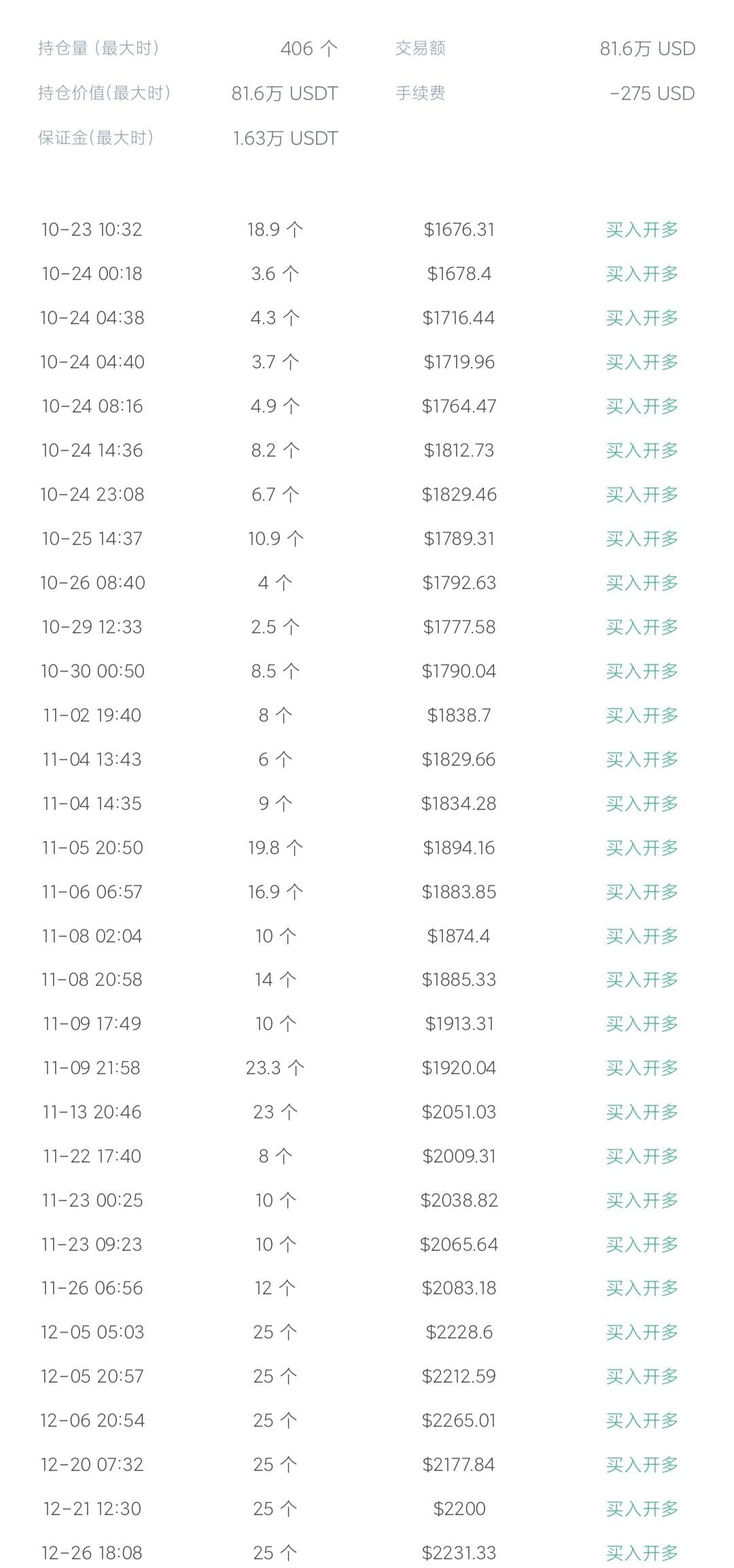
Ethereum rolling position records.
